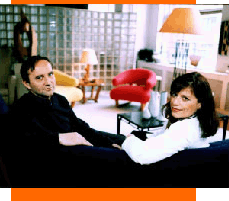
Although they had built a steady clientele of American collectors, decorators and curators during their years working as dealers in Paris and attending "Modernism" fairs in New York and Los Angeles, French XXth century furniture specialists knew they were taking quite a gamble when they decided to move to New York-theirs was the first such French gallery to do so, and many of the architect-designers they specialized in were virtually unknown in the U.S.
The move paid off. Ever since they opened the 3,700-square-foot Galerie in a SoHo loft in February 1996, they have been welcomed by American collectors, to whom they offer a rich, ever-changing inventory of pieces by Jacques Adnet, Jean Prouvé, Jean Royère and Serge Mouille, Georges Jouve among other designers, as well as major historical retrospectives of their work.
The gallery's first New York exhibition, in fall 1997, was devoted to the work of sculptor Alexandre Noll, whom the de Beyries introduced to the American market. With the help of his daughter, Odile Noll, who came over for the show's opening, the de Beyries presented Noll's unique, sensuous wood creations along with his tools, personal archives and photographs.
Two years later, the furniture of architect and designer René Herbst, a pioneer in the use of nickel-plated tubing and an influential figure for many (including Pierre Chareau) in the 20th-century design avant-garde, was the subject of another museum-quality exhibition, the first one devoted to him in the U.S. Attracted to his clean lines, simple volumes and sense of spare elegance, American architects and collectors acquired many of the designer's pieces. A third-generation dealer and member of the prestigious Compagnie Nationale des Experts in Paris (an organization grouping dealers and experts recognized as authorities in their particular fields).
The gallery's spring and fall 2000 presentation of furniture by Jean Royère, including pieces that had never been seen anywhere before, was put together thanks to Catherine and Stéphane de Beyrie's years of research, during which they studied the designer's archives, traveled to the Middle East (where Royère had a flourishing practice) and made the connections that allowed them to acquire pieces directly from the families that had commissioned them in the 1940s and '50s. Accompanied by a book (the first to be devoted solely to Royère's work in English), the show-and the combination of style, opulence, practicality and fun in Royère's designs-won praise and support from collectors and curators alike.
Their life is one of constant research about and contact with the furniture and decorative objects they offer. When they are not walking collectors through their loft, sharing their knowledge about the pieces on display and their designers, they are reading through books and archives and identifying pieces, talking on the telephone with the owners of pieces they have located, or traveling to France-where they spend at least one week per month and where an important number of their clients continue to be located-and other countries, hoping to discover and acquire new material.
